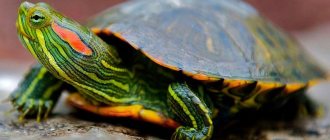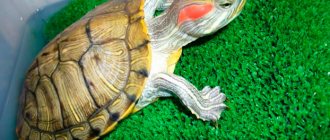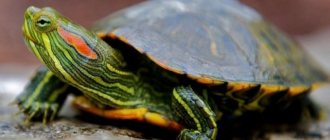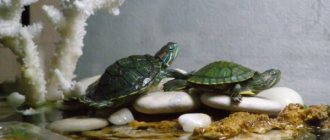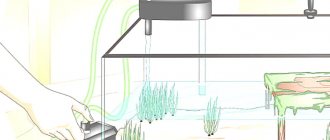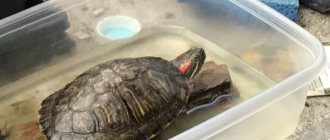In Russia, these exotic aquarium inhabitants are called red-eared, and in Germany - red-cheeked, and all thanks to the presence of a distinctive feature in the turtles - red spots in the cheek-ear area. The second name of the breed is the yellow-bellied turtle, which has a yellow plastron. These reptiles have gained great popularity among aquarists due to their original appearance, relative unpretentiousness and long life cycle. But only a pet that lives in comfortable conditions and receives the required care can live for several decades in captivity. What kind of aquarium is suitable for a red-eared turtle, and how to properly equip it so that your pet feels at home?
Correct selection of the tank
To choose a suitable aquaterrarium for a red-eared turtle, you should focus on the size of the adult individual and general breed characteristics. Even if, upon purchase, the seller assures that representatives of this breed are dwarf turtles and are able to live almost in a box, you should not believe this.
“Little Reds” prefer to spend most of their time in water or even on the ground of an artificial reservoir. Based on the size of adult individuals of this breed, they cannot be called dwarf: the length of males raised in captivity reaches 17 cm, females are 3-4 cm longer.
Capacity volume
As for the volume of the tank, it should be calculated based on the fact that one reptile 12-13 cm long or a couple of 8-10 cm individuals requires a 100 liter container. But it is worth considering that the turtles will grow, develop, and sooner or later their house will have to be replaced with more spacious apartments. For example, two 20-30 cm reptiles will need a tank with a volume of 200-250 liters.
It is important for owners to know that in a small container, water becomes contaminated very quickly, which leads to various diseases that are often diagnosed in red eared cats.
Amount of water
You should not fill the tank full; there should be a distance of at least 20 cm from the water level to the edges. On average, the level does not exceed 2/3 of the container’s volume.
Availability of sushi
Representatives of this breed are swimming reptiles, so they need a piece of land to rest. In addition, they love to get out of the water and bask. Experienced breeders of these pets advise setting aside approximately 20-25% of the total area of the aquaterrarium for an island. It is important that the rise be gentle and non-slip so that the reptile does not have any difficulties when it gets out of the water.
Does an aquarium need a lid?
When arranging a house, it is necessary to take into account that it must have a lid that will reliably protect the container and at the same time allow air to pass through well. Owners who neglect this condition may one day not find the inhabitants in the home. What are the red-eared turtle's chances of surviving without water?
In fact, if you discover the loss in time and go in search, then in most cases the travelers are found - lethargic, but alive. Representatives of this breed can live on land for 1-2 days, but they will not be able to completely avoid drying out.
Important Tips
When planning to set up an aquarium for a red-eared slider, it is important to know that not every tank is suitable for these purposes. You cannot keep reptiles in an aquarium whose volume is less than 50 liters. This house is suitable only for temporary residence.
If an animal lives in such a container for a long time, it will increase the risk of developing dystrophy, skin diseases and softening of the shell. Plastic islands are also not used. The red-eared turtle needs an aquarium where it is possible to install filtration and ultraviolet light, and you can also change the temperature.
To properly set up an aquarium for a turtle, you will need some knowledge. Caring for such a pet will require some effort, as with any other animal. An aquaterrarium with a picturesque bottom, clean water and healthy turtles is a beautiful sight, so you shouldn’t waste time on its arrangement.
Important points when equipping an aquaterrarium
Before installing and equipping the tank, you should consider the following points:
- It is necessary to choose a suitable place for it - it is strictly forbidden to place it in a draft or near a window where direct sunlight will enter the container - both of these can lead to diseases of the inhabitants and subsequent death.
- It is necessary to calculate the volume of water and the size of land - taking into account the length of individuals and their number.
- It is important to take care of a comfortable temperature, high-quality water filtration, lighting equipment and access to a sufficient amount of ultraviolet rays - all this is necessary for the turtles to live a full life.
Water and land
Turtles are not very active reptiles; their rhythm of life differs from the lifestyle of other aquarium inhabitants. But red whales are capable of surprising people - they move quite quickly and can show aggression both towards other inhabitants and towards their fellow creatures.
They live both in the aquatic environment and on land and need moisture, sunlight, and coolness. In general, everything should be in moderation. Crawling out onto the island, the reptile receives the necessary amount of oxygen and also basks in the ultraviolet rays. In nature, reptiles rest on stones, snags, they even climb onto debris or tires, garbage that ends up sticking out of the water.
One part of the land should be located in the water. You can build a non-steep staircase with wide steps or a miniature ladder for your pets, place a large stone with a flat surface or a grotto with a gentle ledge. Special decor for an aquaterrarium can be purchased at a pet store or built with your own hands. In any case, it should not have sharp edges or burrs. Another caveat is that plastic structures cannot be used.
The land must be securely fixed, since if this is not done, a large and physically developed turtle will easily roll up a poorly secured structure. This could cause her serious injury. When choosing a material for an island, you should give preference to high-quality, non-toxic, rough, well-textured products.
It is important that the turtle can move around the tank calmly and without difficulty. If you place dry land next to the walls of the aquarium, your pet will often be injured or may die. Another nuance - it is best to place the island 20-25 cm below the edges of the tank, otherwise the reptile can show miracles of dexterity. Redfish often climb over the walls of aquariums and “go on the run.”
Homemade terrarium for a red-eared turtle
You can make an aquarium for reptiles with your own hands. The assembly process does not require the use of complex devices and technologies.
Necessary materials
To make an aquarium you will need sheets of glass of the required size. You can cut parts in a workshop or at home. The cuts are made even, otherwise the seal of the container is broken. The thickness of the glass walls must be at least 6 mm.
During the assembly process you will need the following materials and devices:
glass cutter
sealant
ruler, square
adhesive tape
sandpaper
It is worth paying attention to preparing the workplace. A large table or free space on the floor will do. After assembly, the aquarium should not be touched for 3-5 days.
When working with glass, use protective gloves and a respirator.
Construction adhesive should not contain toxic components that penetrate into water.
Preference is given to silicone compounds.
Assembling the container
When making a terrarium for a red-eared turtle with your own hands, perform the following steps:
- Process the sections of glass sheets with sandpaper. When grinding, glass particles rise into the air, so you need to wear a mask when working.
- Place adhesive tape on the side wall so that the strip extends over the edge. The next part is placed on the sticky side of the tape. Both parts are installed at right angles with tape inward.
- Using adhesive tape, assemble all sides of the terrarium. The glass sheets are pressed tightly against each other. The sides are aligned parallel.
- Degrease the joints with alcohol and coat them twice with sealant. Each layer is leveled. To prevent glue from getting on the glass, areas adjacent to the joint are covered with masking tape. The sealant should completely fill the joints. Better connections are obtained when using a special gun.
- Install the bottom, securing it with drops of sealant. After checking the evenness, treat the joints with silicone.
- Leave the aquarium until the glue dries, then carefully turn it over. Remove the tape, erasing traces of glue. Treat all seams with a second layer of sealant and allow the composition to dry.
Checking the quality of work
After the joints have hardened, the container is filled with water and left for 2-3 days. If leaks are detected, the seams are treated with another layer of silicone.
A large-volume terrarium is reinforced with stiffening ribs. To do this, install horizontal plastic strips 4 cm wide in the corners. Glue is used for fastening.
Photos of homemade products
A homemade aquaterrarium for turtles is not much different from one bought in a store. You can see what these homemade products look like in the photo.
About water filtration
Clean water is a prerequisite for keeping red-eared turtles, naturally, if the owner cares about the health of his charges. The reptiles themselves leave a lot of garbage and bio-waste; they like to pick up suspended matter and eat in the water. Naturally, all this does not allow the water to remain clean and transparent for a long time.
To provide your pet with a suitable aquatic environment, you should equip the aquarium with special external filters. You can purchase any model, regardless of the type and shape of the tank. It is not recommended to use indoor appliances, as they very quickly become clogged with suspended matter and lose their efficiency.
If the filters function properly, the owner can save himself from frequent cleaning of the tank and complete water changes. To maintain ecological balance in an artificial reservoir, you should change the water weekly by 40-50% of the total volume. The tank can be filled with ordinary water, previously settled at room conditions. This is an important point to rid the water of excess chlorine and other harmful elements.
Temperature Requirements
Stability is important for reptiles - this applies to the temperature of the aquatic environment and air, and it is advisable to maintain the indicators within limits. The optimal temperature for turtles on land is 27°-28°C, in water – from 30° to 32°C. If the air temperature in the tank is allowed to rise significantly (often this occurs due to improper installation and use of lighting fixtures), the animal may overheat and die.
As for water, to maintain indicators it is better not to rely on your own feelings and not to allow it to cool below 20°C. It is advisable to install a heater that maintains the required temperature. You should regularly measure the air and water in the aquarium in order to adjust them in time. And for this you need to install thermometers in the tank.
Aquarium size
Most people buy a turtle when it is still very small, but in the first year of life it grows actively and can increase in size by as much as 10 cm. A three-year-old pet can have a length of up to 20 cm. After this, the turtle’s growth decreases and is about 1 cm per year.
Knowing the approximate size of the turtle in the future, we can safely say that it will need an aquarium of at least 100 liters, or even 200 liters. But this does not mean that a small turtle needs to be placed immediately in such an aquarium. Most likely not, since she will not feel entirely comfortable there.
Providing light and ultraviolet
In their natural environment, red-eared reptiles periodically crawl out of the water onto land, where they warm up by lying on coastal areas. To provide your pet with conditions close to natural, it is advisable to install an artificial lighting device above one of the islands.
There should be a sufficient distance from the island to the light source so that the lamp warms the air to 29°-31°C, but does not overheat the reptile. If several individuals live in the tank, then they can climb on each other’s backs, trying to get closer to the warmth - it is important that they do not come close to the device. At night, lighting and heating devices should be turned off.
Also, these reptiles do not dive very gracefully; they raise a whole cloud of splashes. And then water can fall on the lamp base and destroy this hot part of the device. It is better to cover the lamp with a shade that protects it from moisture and steam.
Often, the owners of these reptiles do not pay due attention to their special need for ultraviolet light. However, only with sufficient illumination is the pet’s body able to independently produce the required amounts of vitamin D3. This element, in turn, is necessary so that calcium supplied with food can be perfectly absorbed.
With a lack of ultraviolet rays, turtles develop rickets, and without timely treatment, individuals die. As a result of practical experiments, it was possible to find out that the ultraviolet lamp should work for about 10-12 hours per day in order to provide the red ear with the necessary rays. The device is installed at a distance of 35-45 cm from the land surface, and the lamps should be replaced every 12 months.
Features of filling and design of the tank
The main principle that you should focus on when equipping a home for red-eared turtles is safety during use. You should not chase beauty, losing sight of the danger of decorative elements - toxic materials, elements with sharp edges and corners - have no place in an aquaterrarium!
Priming
Turtles often eat small pebbles, which can be caused by a lack of minerals, curiosity, or odors that stimulate the reptile's appetite. But whatever causes this behavior, it is dangerous for turtles and can cause serious problems with the gastrointestinal tract, including the death of the inhabitant.
Therefore, you should not place fine soil at the bottom of the tank. In addition, it is more difficult to clean and gets dirty quickly. Experienced owners advise buying pebbles, the particles of which are at least 0.5 cm. But you can completely do without this element, especially since the turtles themselves do not need soil. And if the aquarium looks dull without it, you can place a variety of larger stones on the bottom.
Vegetation
Young turtles love plants, as well as the proximity of small, peaceful fish. But adult individuals perceive both fish and vegetation as food. Adult turtles can seriously damage greenery by eating it outright, so it is better to decorate their house with artificial flora. And if you take into account the dimensions of the individuals, all decorative elements should be fixed using special weights.
Natural driftwood can be used to decorate the home of red whales, but they should first be cleared of bark, grottoes, unusual pebbles, and more.
Reptile Neighborhood
The peaceful appearance of the animal contrasts with the aggressive nature of an active predator. Red-eared turtles and fish are incompatible in the same aquarium. First he will eat small fish, then slowly move on to large ones. The same will be done with other reptiles and mollusks. Easily chews snail shells.
Males of the same species conflict. In conditions of a limited vessel it is fatal. Gets along with the female. The red-eared turtle does not need company. Enjoys searching for food and communicating with the owner.
